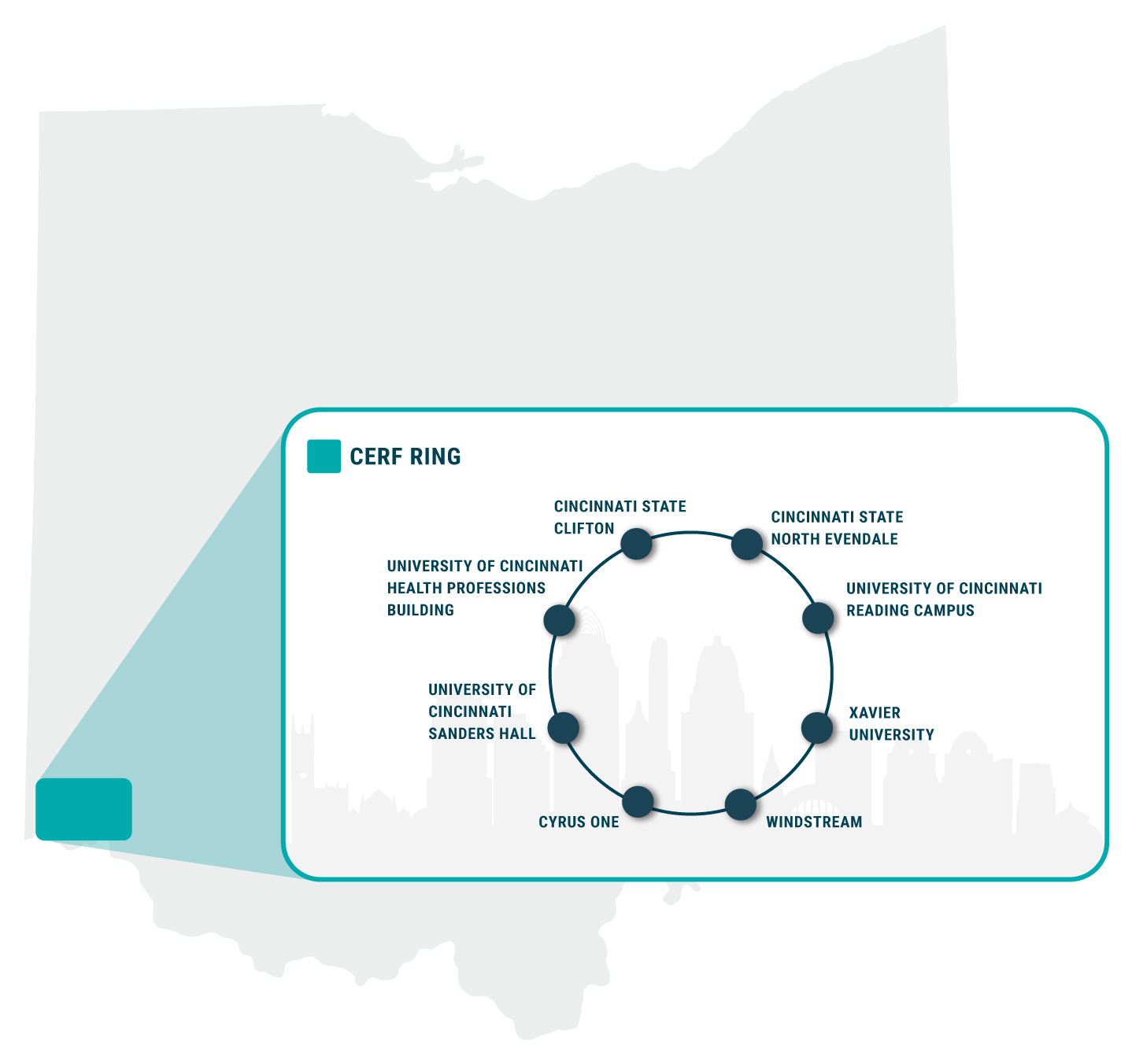For 15 years, the University of Cincinnati, Cincinnati State Technical and Community College and Xavier University shared the Cincinnati Education and Research Fiber Ring (CERF) to support the education and research missions of their schools. When the schools learned in fall 2021 that the CERF ring would no longer be donated by their benefactor, the members reached out to OARnet for assistance.
OARnet manages several other rings for clusters of higher education institutions around the state, such as one that serves the University of Toledo and Bowling Green State University, one used by Case Western Reserve University and Cleveland State University, and another that supports Kent State University, the Northeast Ohio Medical University and Youngstown State University.
A ring is the physical fiber-optic infrastructure, including transmission lines and routing equipment, that links institutions to OARnet’s high-speed network and the internet. A ring connects institutions in two directions, which provides redundancy for continued service in the event of trouble at any single point.

“We have a wealth of experience managing these types of rings, setting up the equipment and provisioning the traditional OARnet services, such as internet, IntraOhio and Internet2 bandwidth. It fits well with our concept of providing redundant architecture to our members,” said Mark Fullmer, OARnet chief technology officer, about the CERF ring request.
In consultation with Chancellor Randy Gardner of the Ohio Department of Higher Education and the three institutions, OARnet agreed to take over management and maintenance of the CERF ring.
OARnet needed to move quickly, as the existing management contract would expire at the end of 2021, to transition a ring that featured infrastructure that was somewhat different from the other higher education rings in the state.
As OARnet’s business relations unit established a memorandum of understanding with the three schools that specified the terms and conditions of the partnership, the engineers swiftly took over. The job raised some challenges, as the CERF ring was built on a different optical system than the one that OARnet uses for the other school rings, said Gary Goettel, network operations manager. In addition, the ring included various pieces of equipment managed by the individual institutions.
After studying how the system was organized, the optical engineers and field team spent many hours over the course of several weeks transitioning the hardware. There was no disruption in service to the institutions.
“It was a tall task, but the group was able to do that,” Goettel said. “Now the universities won’t have to worry about it.”
OARnet’s management of the CERF ring saves the higher education institutions the time and expense of performing equipment upgrades or repairs on their own, said Denis Walsh, chief relationship officer.
The upgraded ring also provides strong reliability. The architecture features built-in backups that protect against service disruptions from equipment or fiber failures.
“It’s mission critical—these schools have to be open; students need to be in classes,” Walsh said.
The universities appreciate that consistency in connectivity.
“The biggest outcome has been the added redundancy OARnet has provided along with assuming the hardware maintenance,” said Randy Sprague, enterprise and infrastructure manager at the Cincinnati State Technical and Community College. “Ring management has been improved with redundant internet connections now being an option.”
OARnet has been highly accessible to the universities, providing strong customer service through its ticket tracking system, Sprague said.
For the University of Cincinnati, the enhanced relationship with OARnet has opened the door to join additional UC campuses to the ring, providing faster and more reliable network connectivity to research facilities that require it, said Matthew Williams, executive director of information security at the University of Cincinnati.
“Transitioning the ring to OARnet made sense both for the present and the future of the university,” Williams said. “It has allowed our network engineers to concentrate on other matters tied closely to our digital transformation.”
Xavier University also has been pleased with the new OARnet service and management of the ring, said Erik Ball, director of technology infrastructure.
“The benefit is that we know that we have excellent service from OARnet as always, and that we are on a managed ring where they will maintain the fiber and optical infrastructure going forward,” Ball said.
Since 1987, OARnet has delivered technology-based solutions that reduce costs, increase productivity and improve customer service. As a division of the Ohio Department of Higher Education's Ohio Technology Consortium (OH-TECH), OARnet serves Ohio's education, health care, public broadcasting and government communities. Other members of the consortium include the Ohio Supercomputer Center (OSC) and the Ohio Library and Information Network (OhioLINK).